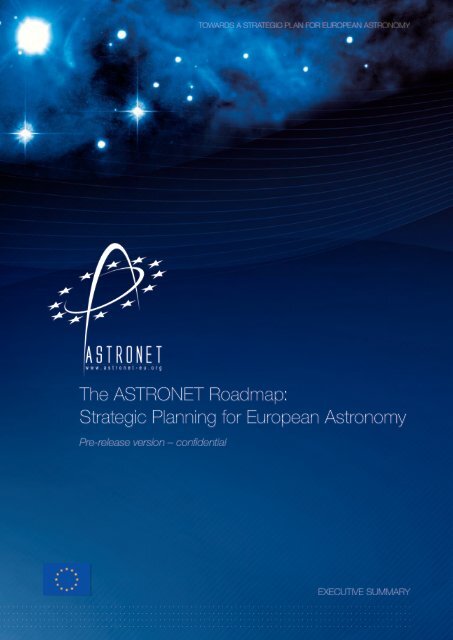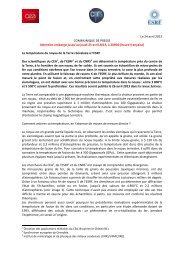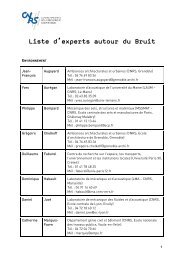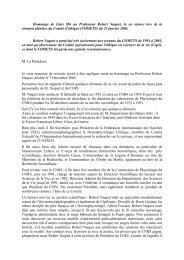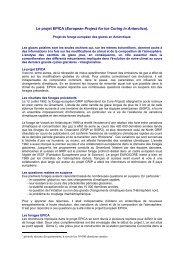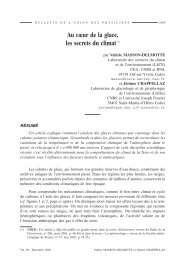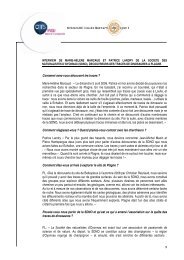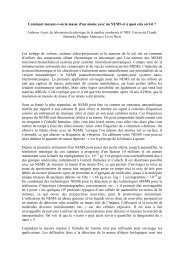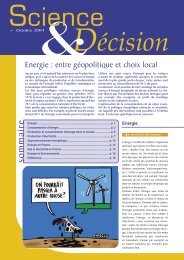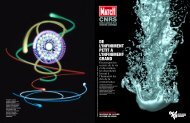The ASTRONET Roadmap: Strategic Planning for European ... - CNRS
The ASTRONET Roadmap: Strategic Planning for European ... - CNRS
The ASTRONET Roadmap: Strategic Planning for European ... - CNRS
- No tags were found...
You also want an ePaper? Increase the reach of your titles
YUMPU automatically turns print PDFs into web optimized ePapers that Google loves.
TOWARDS A STRATEGIC PLAN FOR EUROPEAN ASTRONOMY<strong>The</strong> <strong>ASTRONET</strong> <strong>Roadmap</strong>:<strong>Strategic</strong> <strong>Planning</strong> <strong>for</strong> <strong>European</strong> AstronomyPre-release version – confidentialEXECUTIVE SUMMARY
InsuCONFÉRENCE DE PRESSEL’Europe dévoile son plan à 20 ans pour l’astronomie25 novembre 2008, 10 heuresAcadémie des sciences, Palais de l’Institut,23, quai de Conti, 75006 Paris - FranceOrateurs :- Jean Dercourt, Secrétaire perpétuel de l’Académie des sciences, Introduction.- Jean-Marie Hameury, coordinateur <strong>ASTRONET</strong>, directeur adjoint de l’Institut national des sciences del'Univers du <strong>CNRS</strong>, Qu’est ce qu’<strong>ASTRONET</strong> ?- Johannes Andersen, Président du conseil <strong>ASTRONET</strong>, directeur du Nordic Optical Telescope à LaPalma (Iles Canaries), Le rôle de la feuille de route d’<strong>ASTRONET</strong>.- Michael Bode, responsable du groupe de travail de la feuille de route d’<strong>ASTRONET</strong>, directeur del’Institut de recherche en astrophysique de l’Université John Moores à Liverpool, La feuille de routed’<strong>ASTRONET</strong>.ContactsPresse <strong>CNRS</strong> l Claire Le Poulennec l T 01 44 96 49 88 l claire.le-poulennec@cnrs-dir.frCommunication INSU l Philippe Chauvin l T 01 44 96 43 36 l philippe.chauvin@cnrs-dir.fr
InsuCOMMUNIQUE DE PRESSE I PARIS I 25 NOVEMBRE 2008L’Europe dévoile son plan à 20 ans pour l’ast ronomieDans le paysage de l’astronomie mondiale, l’Europe joue un rôle de leader grâce à unecoopération toujours plus efficace de sa communauté scientifique depuis 50 ans. Pour semaintenir au même niveau dans les prochaines décennies, elle doit se fixer des priorités etcoordonner encore plus étroitement ses investissements financiers et humains. Cettetâche est revenue au réseau <strong>ASTRONET</strong>, soutenu par la Commission Européenne,coordonné par l’Institut national des sciences de l’univers du <strong>CNRS</strong>, et qui rassemble toutela communauté astronomique européenne. Aujourd’hui, <strong>ASTRONET</strong> présente sa Feuille deroute des infrastrucutres pour assurer un avenir brillant à l’astronomie européenne dedemain.L’Europe joue aujourd’hui un rôle de leader en astronomie, avec l’observatoire optique le plus puissant aumonde et des infrastructures de pointe dans de nombreux domaines, de la radioastronomie au sol auxsondes spatiales. Dans ce contexte, les astronomes européens se sont réunis pour identifier les défisscientifiques de demain et les moyens en équipement pour y répondre, en optimisant les coûts. Ilsdémontrent ainsi la réalité de la coopération européenne.En 2007, ces astronomes avaient examiné les questions scientifiques les plus brûlantes du prochain quartde siècle, allant de l’énergie noire à la vie sur les autres planètes, et avaient ainsi élaboré une Visionscientifique à long terme. Ils présentent aujourd’hui leur Feuille de route des infrastructures européennes,un plan global à 20 ans pour coordonner les investissements nationaux et communautaires. La feuille deroute hiérarchise les nouveaux grands équipements nécessaires à la recherche en astrophysique, au solcomme dans l’espace. Elle prend également en considération les infrastructures existantes, les ressourceshumaines, l’infrastructure TIC (technologies de l’in<strong>for</strong>mation et de la communication), la vulgarisation et ladiffusion des connaissances auprès du grand public. Elle contient les coûts estimés de construction et defonctionnement.Cette feuille de route a été élaborée sous l’égide du programme <strong>ASTRONET</strong>, créé par les grandesagences de financement européennes, bénéficiant du soutien de la commission européenneet coordonnépar l’Institut national des sciences de l’Univers (INSU) du <strong>CNRS</strong>. Pour établir un consensus sur lespriorités à donner au sein d’une communauté très diverse, la vision scientifique et la feuille de route ont étéconçues grâce à une interaction de toute la communauté, à travers de grands colloques et débats surInternet. Résultat : la feuille de route est soutenue par les astronomes des 28 États membres et associésde l’Union européenne, dont la population dépasse les 500 millions d’habitants.Plus de 60 experts, sélectionnés partout en Europe, ont contribué à la construction de la feuille de routed’<strong>ASTRONET</strong>, garantissant ainsi que l’astronomie européenne aura les outils nécessaires pour releveravec succès les défis de la vision scientifique. Ils ont identifié et hiérarchisé les nouvelles infrastructures
Insunécessaires pour observer l’Univers, dans le domaine des longueurs d’onde allant de la radio aux rayonsgamma, en utilisant de nouveaux moyens d’étude du cosmos comme les ondes gravitationnelles, ou enallant plus loin dans l’exploration de notre système solaire. Au cours de cette procédure, ils ont pris encompte tous les éléments susceptibles de rendre leur entreprise scientifique fructueuse, tels que lacoopération à l’échelle mondiale concernant les mégaprojets les plus importants ou encore les besoin de<strong>for</strong>mation et de recrutement de jeunes scientifiques et ingénieurs qualifiés.Les projets les plus importants 1 pour <strong>ASTRONET</strong> sont :Parmi les projets à grande échelle au sol :- le <strong>European</strong> Extremly Large Telescope, de loin le plus grand télescope optique, doté d’un miroirsegmenté pour étudier le ciel en lumière visible et infrarouge ;- le Square Kilometre Array, un grand radiotélescope qui sera déployé à l’échelle d’un continent.Le SKA serait porté par un consortium mondial.Parmi les instruments de premier plan, mais nécessitant un investissement moindre :- un télescope solaire européen de 4 mètres, qui sera basé dans les Iles Canaries ;- un réseau de télescopes optiques dédié aux rayons gamma émis par les trous noirs ou pard’autres sources très énergétiques ;- un télescope sous mer pour détecter les neutrinos – des particules sub-atomiques quipeuvent traverser la Terre de part en part et qui fournissent des in<strong>for</strong>mations sur certains desphénomènes les plus violents de l’Univers.Parmi les missions spatiales les plus importantes pour la prochaine décennie, les priorités d’<strong>ASTRONET</strong>sont :- une mission pour étudier les ondes gravitationnelles issues du Big bang et des trous noirs ;- une mission pour étudier, en rayons X, les galaxies, les amas de galaxies et les étoiles, plusfinement que cela n’a jamais été fait auparavant ;- deux missions pour étudier les planètes Jupiter, Saturne et leurs satellites.Des projets spatiaux tout aussi importants, mais moins coûteux:- une mission pour percer les secrets de la matière sombre et de l’énergie noire ;- une mission pour comprendre notre étoile, le Soleil, plus en détail que cela n’ a jamais été réaliséauparavant.Parmi les autres recommandations, les astronomes d’<strong>ASTRONET</strong> ont réfléchi à la façon d’utiliser au mieuxles infrastructures existantes, tant du point de vue scientifique que des coûts. Ils ont également souligné lanécessité d’améliorer l’accès aux équipements in<strong>for</strong>matiques et aux équipements de pointe de certainslaboratoires. L’industrie de haute technologie européenne devrait être davantage impliquée dans laconception des futures infrastructures. En outre, la réussite dépend de l’existence et de la disponibilité desscientifiques et ingénieurs qualifiés, dans les nombreux domaines concernés allant de l’in<strong>for</strong>matique à1 Il s’agit des projets figurant en tête de liste. L’intégralité de la feuille de route, ainsi qu’ un document de synthèse, sont disponibles surle site Internet www.astronet-eu.org
Insul’optique. Enfin, la feuille de route propose une série de mesures de vulgarisation, visant à susciter desvocations scientifiques et technologiques.L’Europe dépense aujourd’hui deux milliards d’euros environ, par an, pour l’astronomie au sens large. Lamise en œuvre de la feuille de route d’<strong>ASTRONET</strong> nécessitera une augmentation des financementsd’environ 20 pour cent du budget consacré aux très grandes infrastructures de recherche— largementmoins d’un euro par an et par citoyen européen. Une coopération mondiale, en cours de planification, seranécessaire pour les projets les plus importants.In<strong>for</strong>mations complémentaires<strong>ASTRONET</strong> a tout d’abord élaboré une Vision Scientifique de l’astronomie européenne ( publiée en octobre2007), en passant en revue et en hiérarchisant, par ordre de priorité, les principales questions scientifiquesque l’astronomie européenne devrait traiter au cours des 10 ou 20 prochaines années. La Feuille de routed’<strong>ASTRONET</strong>, qui s’appuie sur ce travail, a été élaborée par un groupe de travail nommé par le conseild’<strong>ASTRONET</strong>. Les projets concernant des infrastructures existantes ou en projet – plus d’une centaine autotal – ont été examinés par trois groupes de travail spécialisés composés de scientifiques européens.Deux autres groupes ont réfléchi sur les besoins concernant la théorie, l’in<strong>for</strong>matique et la mise àdisposition des données, ainsi que les ressources humaines, y compris l’éducation, le recrutement, ladiffusion des connaissances auprès du grand public et l’engagement industriel.La feuille de route concerne des projets qui nécessitent un investissement européen de 10 millions d’eurosou plus, à décider à partir de 2009. Les critères d’évaluation utilisés sont le retour scientifique potentiel,l’originalité du projet, son importance pour l’Europe, le nombre d’astronomes qui en bénéficieraient et leurimpact sur l’industrie de haute technologie européenne. La communauté scientifique a été sollicitée pourfinaliser ce rapport, à travers un <strong>for</strong>um de discussions sur Internet et le symposium de Liverpool, en juin2008.A propos d’<strong>ASTRONET</strong>: www.astronet-eu.o rgLe document de synthèse et l’intégralité de la feuille de route sont disponibles sur ce site, ainsi que desimages à télécharger<strong>The</strong> <strong>European</strong> Extremely Large Telescope : http://www.eso.org/sci/facilities/eelt/E-ELTVidéos du E-ELT : http://www.eso.org/gallery/v/Videos/E-ELT/Images du E-ELT : www.eso.org/gallery/v/ESOPIA/EELT/Animations du radiotélescope Square Kilometre Array :www.skatelescope.org/video/SKA_Animation_High.mpgAnimation ExoMars :www.esa.int/esa-mmg/mmg.pl?b=b&type=IVA&mission=ExoMars&single=y&start=1&size=b
InsuContactsMichael Bode l Responsable du groupe de travail de la feuille de route d’<strong>ASTRONET</strong>, directeur del’Institut de recherche en astrophysique de l’Université John Moores à Liverpool, l Bureau +44 151 2312920/2919 Portable +44 7968 422312 l mfb@astro.livjm.ac.ukJohannes Andersen l Président du conseil <strong>ASTRONET</strong>, directeur du Nordic Optical Telescope à LaPalma l +45 353 25934 l ja@astro.ku.dkJean-Marie Hameury l Coordinateur <strong>ASTRONET</strong>, Directeur adjoint de l’Institutnational des sciences del’Univers du <strong>CNRS</strong> l T +33 1 44 96 43 77 l jean-marie.hameury@cnrs-dir.frPresse <strong>CNRS</strong> l Claire Le Poulennec l T +33 1 44 96 49 88 l claire.le-poulennec@cnrs-dir.frCommunication INSU l Philippe Chauvin l T +33 1 44 96 43 36 l philippe.chauvin@cnrs-dir.fr
<strong>ASTRONET</strong>: Towards a <strong>Strategic</strong>Plan <strong>for</strong> <strong>European</strong> AstronomyJean-MarieHameuryDirecteur adjoint de l’Institut National des Sciences del’Univers du <strong>CNRS</strong>Coordinator of Astronet
What is Astronet ? ERA-NET, funded by EU FP6– Consortium of funding agencies– Comprehensive view of <strong>European</strong> astronomy– Development of a common global strategy <strong>for</strong><strong>European</strong> astronomy Contractors/associates/<strong>for</strong>um members:– About 30 participants from ~ 20 countries– Almost all <strong>European</strong> countries in which astronomy ispresent, but a few exceptions (Belgium, Ireland,Portugal
Science Vision Key QuestionsA: Do we understand the extremes of theUniverse?B: How do galaxies <strong>for</strong>m and evolve?C: What is the origin and evolution of starsand planetary systems?D: How do we fit in?Developed in sufficient detail to allow identification ofgeneric capabilities needed to deliver the VisionWP leader: T. de Zeeuw (Leiden)
“A A Grand Vision <strong>for</strong> Astronomy”Symposium in Poitiers(January 2007)Published 28 September 2007Available as a PDF file at:http://www.astronet-eu.orgeu.org/
<strong>The</strong> Role of the<strong>ASTRONET</strong> <strong>Roadmap</strong>J. AndersenDirector, Nordic Optical Telescope, La Palma&<strong>ASTRONET</strong> Board Chair<strong>ASTRONET</strong> <strong>Roadmap</strong> Presentation J. Andersen Paris, November 25, 2008
Needs in 2010-2025 2025 <strong>for</strong><strong>European</strong> Astronomy:New:E-ELTELTButalso:SKAVLT, Paranal- andpeople!ORM, La Palma<strong>ASTRONET</strong> <strong>Roadmap</strong> Presentation J. Andersen Paris, November 25, 2008
Who Pays <strong>for</strong><strong>European</strong> Astronomy?National & local governments (~99%):• Membership of <strong>European</strong> organisations (ESO, ESA…)• National & bi/multilateral projects (CFHT, IRAM, LBT…)• National & <strong>European</strong> supercomputers and networks• National & local research institutes and universities• Training the people we all needEU+ (~1%): <strong>ASTRONET</strong>, OPTICON, design studies…<strong>ASTRONET</strong> <strong>Roadmap</strong> Presentation J. Andersen Paris, November 25, 2008
Who Else Plans the Futureof <strong>European</strong> Astronomy?• National strategic plans (not all countries have them)- Astronomy is international; coordination needed• ESA/ESO long-range plans- Limited to own investments; only part of the picture• ESFRI <strong>Roadmap</strong> (by national representatives)- Only few, very largest projects (omits space, particles)-No priorities, schedule; no overall view of each field• OECD Global Science ForumOECD Global Science Forum- Global aspects only; needs common <strong>European</strong> position<strong>ASTRONET</strong> <strong>Roadmap</strong> Presentation J. Andersen Paris, November 25, 2008
<strong>The</strong> Role of the<strong>ASTRONET</strong> <strong>Roadmap</strong>:To give funding agencies a comprehensive,science-basedplan <strong>for</strong> all of astronomy:• Coordinated investments in new, large/global facilities• Cover all wavelengths, ground & space, astroparticles…• Consider balance between new & existing facilities• Include archiving, theory, computing, networks…• Include education, recruitment, outreach, spinoffs• Estimate costs honestly(!); include operations, staff..• Propose realistic project and investment schedules► Prepare rational, coordinated funding decisions<strong>ASTRONET</strong> <strong>Roadmap</strong> Presentation J. Andersen Paris, November 25, 2008
A Tough Task?A euphemism!• Scientific priorities must be set (Science Vision!)• Financial limitations become painfully clear• Compromises must be made by the community• Many dreams suffer early, brutal death, but…- we all understand that it makes sense, and- we do not have the option of not doing our best• <strong>Roadmap</strong> in hand, we will work with ESFRI, GSF…• <strong>The</strong>n it is up to governments and agencies to act!<strong>ASTRONET</strong> <strong>Roadmap</strong> Presentation J. Andersen Paris, November 25, 2008
<strong>The</strong> <strong>ASTRONET</strong> <strong>Roadmap</strong>Professor Michael BodeLiverpool John Moores University, UK<strong>Roadmap</strong> Task Leader
What it Aims to doProvide a realistic plan <strong>for</strong>the facilities and generalinfrastructure needed toaddress the big questionsposed in the ScienceVision, e.g.:! Is there life elsewhere?! How did galaxies, starsand planets come to be?! How do the most violentexplosions in theUniverse actually work?! What is the nature of DarkEnergy and Dark Matter?And enhance <strong>European</strong>education and industry
How We Worked! Over 60 experts in a Working Group and 5Panels! 3 Panels reviewed over 100 facilities! Another concentrated on theory, computing,and data archiving! <strong>The</strong> fifth covered human resources, includingeducation, recruitment, public outreach andindustrial involvement40 meetings plus Liverpool Symposium
Conclusions: Future LargeGround-Based Projects! <strong>European</strong> ExtremelyLarge Telescope (E-ELT)Phased Plan to deliver both projects! Square Kilometre Array(SKA - radio telescope)
Ground-Based Medium Scale! <strong>European</strong> SolarTelescope! Cherenkov TelescopeArray (CTA - Cosmicgamma rays)! KM3Net (underwaterneutrino telescope)! Plus Small Scale:Wide-Field Spectrograph(Dark Energy)
Large Scale Space Missions! XEUS/IXO (AdvancedX-ray observatory)and LISA(Gravitational Waves)! TandEM or LAPLACE(giant planets)! ExoMars
Medium Scale Space Missions! Gaia (Milky Way mapping- Science Exploitation)! EUCLID (Dark Energy)! Cross-Scale, PLATO,Simbol-X, , SPICA (range ofscience objectives)! Solar Orbiter! Marco Polo(AsteroidRendezvous)
Existing Observational Facilities! Recommended prolongation of the most successfulspace missions! Ground-based telescope reviews
Lab Astrophysics; <strong>The</strong>ory,Computing, Virtual Observatory! Pan-<strong>European</strong> (Virtual)Astrophysical SoftwareLab! Enhanced LaboratoryAstrophysics! Further Developmentof the <strong>European</strong> VirtualObservatory
Wider Impact! Improvements incommunication to the public! Measures to enhance scienceand technology education! Greater interaction with<strong>European</strong> industry! Enhanced scientific exploitationof results! Provision of adequate numbersof highly skilled people
Conclusions! To implement the full recommendations <strong>for</strong> this fundamentalscience will require a budget increase of around 20%! <strong>The</strong> <strong>Roadmap</strong> will then enable Europe to take the lead inaddressing some of the major scientific questions of our time! It will also enhance the scientific and technical capability ofEurope at all levels! And enable us to work effectively with our wider internationalpartners on some of the largest-scale, global projects overthe next two decades
TOWARDS A STRATEGIC PLAN FOR EUROPEAN ASTRONOMY<strong>The</strong> <strong>ASTRONET</strong> <strong>Roadmap</strong>:<strong>Strategic</strong> <strong>Planning</strong> <strong>for</strong> <strong>European</strong> AstronomyPre-release version – confidentialEXECUTIVE SUMMARY
Background: <strong>The</strong> Global Scientific ContextThis is a golden era <strong>for</strong> astronomy. <strong>The</strong> past few years have brought a number of epochal discoveries, from the detectionof the first planets orbiting other stars, to the accelerating Universe dominated by enigmatic dark energy. Europe isat the <strong>for</strong>efront in all areas of contemporary astronomy and the challenge now is to consolidate and strengthen this position<strong>for</strong> the future.In a world of ever-fiercer global competition, <strong>European</strong> astronomy has reached its current position by learning to cooperateon both a bi- and a multilateral basis, and especially through the <strong>European</strong> Southern Observatory (ESO) and the <strong>European</strong>Space Agency (ESA). However, the scientists and research programmes in universities and research organisations at thenational level remain the backbone of <strong>European</strong> astronomy. <strong>The</strong> scientific challenges of the future will require a comprehensivelong-term strategy and the coordination of financial and human resources, underpinned by vibrant, national scientificand technological communities across the whole of Europe. This approach is also needed if Europe is to be a strongand effective partner in the largest, global projects.<strong>ASTRONET</strong>, supported as an ERA-Net by the <strong>European</strong> Commission, was created by the major <strong>European</strong> funding agenciesand research organisations to prepare long-term scientific and investment plans <strong>for</strong> <strong>European</strong> astronomy <strong>for</strong> thenext 10–20 years. <strong>The</strong> present Infrastructure <strong>Roadmap</strong> represents the core of this ef<strong>for</strong>t and is unique in the history of<strong>European</strong> astronomy. Firstly, it considers the whole of astronomy: from gamma-ray to radio wavelengths as well as particles,from the ground and in space, and from the distant borders of the Universe to in situ exploration of Solar Systembodies, and includes theory, computing and laboratory studies. Secondly, it involves all of Europe, including the new EUmember states, and explicitly includes the human resources that are crucial to the delivery of the scientific outcome.We know that astronomy interests peopleof all ages; as well as expanding theirhorizons, it can encourage younger peopleto consider careers in science or technology.Astronomy also drives high technologyin areas such as optics and in<strong>for</strong>matics.<strong>The</strong>se are all powerful reasons to support<strong>European</strong> astronomy. As this report shows,astronomy is also a fully international sciencewhose communities welcome theestablishment of the <strong>European</strong> ResearchArea.Credit: NASA, ESA, CXC, M. Bradac (University of Cali<strong>for</strong>nia, Santa Barbara, USA), and S. Allen (Stan<strong>for</strong>d University, USA)Hubble and Chandra composite of the galaxy clusterMACS J0025.4-1222, showing the hot, diffuse gastrapped in the cluster’s powerful gravitational field.2
TOWARDS A STRATEGIC PLAN FOR EUROPEAN ASTRONOMYScience-Driven PrioritisationScientific planning must be based on scientific goals.Accordingly, this process began with the development ofa Science Vision <strong>for</strong> <strong>European</strong> Astronomy, published inOctober 2007. It reviewed and prioritised the main scientificquestions that <strong>European</strong> astronomy should address overthe next 10–20 years under four broad headings:• Do we understand the extremes of the Universe?• How do galaxies <strong>for</strong>m and evolve?• What is the origin and evolution of stars and planets?• How do we fit in?In doing so, the Science Vision identified the types ofresearch infrastructure that would be needed to answerthe key questions under each heading, but did not addressspecific projects. <strong>The</strong> present Infrastructure <strong>Roadmap</strong>builds on the Science Vision. It aims to develop a matchingset of priorities <strong>for</strong> the material and human resourcesneeded to reach these goals, and a plan <strong>for</strong> phasing thecorresponding investments so that the bulk of the ScienceVision goals can be reached within realistic budgets. Itextends the ESFRI <strong>Roadmap</strong> by analysing and comparingthe flagship projects in all areas of astronomy in technicaland financial detail, and by addressing directly the hardfacts of the implementation phase.<strong>The</strong> Working Group and Panels were mindful of existingnational and international strategic plans, including those ofESFRI, ESO and ESA. <strong>The</strong>y also considered the global context,including the plans of our major international partners.Close contact was maintained with the infrastructure networksOPTICON, RadioNet, EuroPlaNet and ILIAS and theERA-Net ASPERA. <strong>The</strong> Working Group has sole responsibility<strong>for</strong> the final report.Three aspects of the <strong>Roadmap</strong> are notable. Firstly, itemphasises the need to include the entire electromagneticspectrum — and beyond — in the study of most cosmicphenomena, from young stars and planets to supermassiveblack holes in the distant Universe. Secondly, thepriorities of proposed new space missions were reviewedindependently by the <strong>ASTRONET</strong> and ESA Cosmic Visionpanels. Although they were prepared by different groupsof scientists, the conclusions were very similar. Thirdly, the<strong>Roadmap</strong> identifies a number of gaps, <strong>for</strong> which technologicalsolutions are needed, as well as inconsistencies in currentpolicies. It points to the lack of consistency betweenthe resources devoted to major projects and their scientificexploitation, and to the need to coordinate space projectswith the matching ground-based ef<strong>for</strong>ts that are needed tosecure the full scientific returns from the investment.<strong>The</strong> <strong>ASTRONET</strong> <strong>Roadmap</strong> was developed primarily onscientific grounds by a Working Group appointed by the<strong>ASTRONET</strong> Board. Existing and proposed infrastructureprojects across astronomy — well over 100 in all —were reviewed by three specialist panels of top-ranking<strong>European</strong> scientists. Two other panels considered the concomitantneeds <strong>for</strong> theory, computing and data archiving,and human resources including education, recruitment,public outreach and industrial involvement. Overall, over60 <strong>European</strong> scientists were directly involved in this ef<strong>for</strong>t.Feedback from the community was invited through botha web-based <strong>for</strong>um and a large symposium held in June2008.<strong>The</strong> panels worked by assessing projects requiring newfunds of €10 million or more from <strong>European</strong> sources andon which spending decisions are required after 2008. <strong>The</strong>yexamined each project <strong>for</strong> its potential scientific impact, itsuniqueness, its level of <strong>European</strong> input, the size of the astronomicalcommunity that would benefit from it, and its relevanceto advancing <strong>European</strong> high-technology industry.Artist’s impression of the the extrasolar planet HD 189733b.Credit: ESA/Hubble/M. Kornmesser3
Financial and Human ResourcesA useful roadmap must include realistic estimates of costs, technological readiness and available resources. Independentadvice as well as in<strong>for</strong>mation provided by the projects have been used to assess their cost and maturity, but the reliabilityof these data varies from project to project. For future space missions in particular, projects have been changing andmerging either internally or with other projects internationally while this report was being prepared. Resource estimates,and also scientific capabilities given here should be regarded as a snapshot of the current situation, based on the bestin<strong>for</strong>mation available to date. Known or estimated costs <strong>for</strong> operations are included throughout.More surprisingly, the available in<strong>for</strong>mation on present financial and human resources <strong>for</strong> <strong>European</strong> astronomy is itselffragmentary and inconsistent, especially when national universities, projects, and bi- or multilateral collaborations are tobe included in addition to ESO, ESA and national funding agencies. <strong>The</strong> demarcation between astronomy and other naturalsciences such as physics, chemistry or biology is another source of uncertainty. A breakdown of resources into astronomicaldisciplines such as cosmology or exoplanet research is not possible, and substantial ef<strong>for</strong>t will be required toachieve it. This report can give only approximate totals, but they do represent the best pan-<strong>European</strong> in<strong>for</strong>mation availabletoday.In the following, ground-based and space-based projects are considered separately, as the funding sources and projectselection procedures <strong>for</strong> them are often separate. <strong>The</strong> recommendations are, however, based on the overall scientific perspectivesdescribed in the Science Vision.Artist’s impression of the <strong>European</strong> Extremely Large Telescope (E-ELT)during observations. In the background the centre of the Milky Way is justrising above the enclosure of the telescope.Credit: ESO/H. Zodet4
TOWARDS A STRATEGIC PLAN FOR EUROPEAN ASTRONOMYGround-Based ProjectsAmong the ground-based infrastructure projects, twoemerged as clear top priorities due to their potential <strong>for</strong>fundamental breakthroughs in a very wide range of scientificfields, from the Solar and other planetary systems tocosmology:• T h e <strong>European</strong> Extremely Large Telescope (E-ELT), a40-m-class optical-infrared telescope being developedby ESO as a <strong>European</strong> or <strong>European</strong>-led project. A decisionon construction, based on a detailed design andcost estimate, is planned <strong>for</strong> 2010.• T h e Square Kilometre Array (SKA), a huge radio telescopebeing developed by a global consortium with anintended <strong>European</strong> share of 33-40 per cent. <strong>The</strong> SKAwill be developed in three phases of increasing size, scientificpower, and cost. Construction of Phase 1 couldbe decided in 2012, followed by first science and a decisionon Phase 2 around 2016, and with Phase 3 envisagedafter 2020.It was concluded that although the E-ELT and SKA arevery ambitious projects requiring large human and financialresources, they can both be delivered via an appropriatelyphased plan.Three other projects were considered scientifically outstandingin areas with <strong>European</strong> leadership, but in narrowerfields and with lower budgets than the E-ELT andSKA. <strong>The</strong>se have been grouped together in a separate listwhich comprises, in descending order of priority:• <strong>The</strong> <strong>European</strong> Solar Telescope (EST), an advanced 4-msolar telescope to be built in the Canary Islands. <strong>The</strong> ESTwill enable breakthroughs in our understanding of thesolar magnetic field and its relations with the heliosphereand the Earth; when ready, it will replace the existingnational solar telescopes in the Canary Islands.• T h e Cerenkov Telescope Array (CTA), an array of opticaltelescopes to detect high energy gamma rays from blackholes and other extreme phenomena in the Universe.Building on existing successful <strong>European</strong> experiments,the CTA — the first true observatory at such energies —is expected to bring about a breakthrough in our understandingof the origin and production of high energygamma rays.• <strong>The</strong> proposed underwater neutrino detector, KM3NeT,was also considered of great scientific potential, butranked lower than the CTA because of the more provenastrophysical discovery capability of the latter.A smaller project, but again of high priority, is a wide-fieldspectrograph <strong>for</strong> massive surveys with 8–10-m telescopes.A Working Group is to be appointed by <strong>ASTRONET</strong> tostudy this in detail. Finally, the report identifies a need toincorporate and support laboratory astrophysics — includingthe curation of Solar System material returned by spacemissions — more systematically than now.Artist’s view of the central element of the Square Kilometre Array. <strong>The</strong>phased elements will be able to observe the whole sky and study multipleobjects simultaneously with independent beams. Surrounding the centralelements is a widely distributed array of antenna dishes providing addedsensitivity and resolution.Credit: SKA5
Space MissionsAlthough important national and multinational space projects are being developed outside the ESA structure and the<strong>Roadmap</strong> also encourages the continued development of fast-track smaller missions, ESA’s strategic planning, mostrecently the Cosmic Vision exercise, dominates the development of major scientific space missions in Europe. Regardlessof scientific merit, only a couple of new L-class (Large scale) and a very few M-class (Medium scale) missions are likely tobe selected or implemented in the next decade within the Cosmic Vision plan; mission proposals are currently undergoingmajor changes and trans<strong>for</strong>mations be<strong>for</strong>e the final selection is made. <strong>The</strong>ir overall impact depends on maintaining astrong science programme at ESA.<strong>The</strong> <strong>Roadmap</strong> Working Group and Panels independently agreed with ESA’s initial selection of Cosmic Vision missions. Allthe proposed missions were judged to be of high scientific value. <strong>The</strong> final choice of missions by the standard ESA reviewand down-selection procedures, which track changes in mission scope and cost and possible mergers with, or replacementby, other <strong>European</strong> or international projects, is there<strong>for</strong>e broadly supported. Within this framework, our priorities,including some non-ESA missions, are as follows:• Among the large-scale missions, the gravitational-wave observatory LISA and the X-ray observatory XEUS/IXO wereranked together at the top. Next were the TANDEM and LAPLACE missions to the planets Saturn and Jupiter and theirsatellites. One is likely to be selected late in 2008 and will then compete with IXO or LISA <strong>for</strong> the next L-slot. ExoMarswas ranked highly as well, but below TANDEM/LAPLACE and does not compete with the others as it belongs to a differentprogramme (Aurora). <strong>The</strong> longer-term missions Darwin (search <strong>for</strong> life on “other Earths”), FIRI (<strong>for</strong>mation and evolutionof planets, stars and galaxies), and PHOIBOS (very close-up study of the solar atmosphere) were also deemedvery important but still require lengthy technological development. It was regarded as premature to assign a detailedpriority ranking to these three missions at this stage.• Among the medium-scale missions, scienceanalysis and exploitation <strong>for</strong> theastrometric mission Gaia was rankedhighest, followed by the dark energy missionEUCLID and then Solar Orbiter. Next,with equal rank but different maturity, areCross-Scale (magnetosphere), Simbol-X(a non-ESA X-ray project), PLATO (exoplanettransits) and SPICA (far-infraredobservatory). Below these in priority isMarco Polo (near-Earth asteroid samplereturn).Left: ESA’s Gaia spacecraft: artist’s impression.Credit: ESARight: <strong>The</strong> young, star-<strong>for</strong>ming Tarantula Nebula inthe Large Magellanic Cloud. <strong>The</strong> colours show thelocations of the many massive, hot young stars andthe heated and ionised regions they have carved outof their natal gas cloud.Credit: ESO/ J. Alves, B. Vandame, Y. Bialetski, R. Fosbury6
TOWARDS A STRATEGIC PLAN FOR EUROPEAN ASTRONOMY7
<strong>The</strong> Role of Existing Facilities<strong>The</strong> role of existing and approved facilities is also considered in the <strong>Roadmap</strong>. In space, several current missions are sosuccessful that an extension of their operational lifetimes beyond those already approved is richly justified on scientificgrounds. In a constrained environment, the selection of the missions that can be extended within available funds shouldbe based on the scientific productivity of the mission and, <strong>for</strong> ESA-supported missions, the overall balance in the ESAprogramme.On the ground, the existing set of small to medium-size optical telescopes is a heterogeneous mix of national and commoninstruments, equipped and operated without overall coordination. This is inefficient and is an impediment to effectiveground-based support <strong>for</strong> space missions. <strong>ASTRONET</strong> has appointed a committee to review the future role, organisationand funding of the <strong>European</strong> 2–4-m optical telescopes within the context of the <strong>Roadmap</strong>, to report by September2009. Reviews of Europe’s existing mm-submm and radio telescopes will be undertaken shortly after, followed later by areview focusing on the optimum exploitation of our access to 8–10-m optical telescopes as we enter the era of the E-ELT.Together, these reviews will enable Europe to establish a coherent, cost-effective complement of mid-size facilities.<strong>The</strong> four 8-m telescopes of the ESO Very Large Telescope (VLT), on CerroParanal in Chile.Credit: ESO/H. H. Heyer8
TOWARDS A STRATEGIC PLAN FOR EUROPEAN ASTRONOMY<strong>The</strong>ory, Computing and Data Archiving<strong>The</strong> development of theory and computing capacitymust go hand-in-hand with that of observational facilities.Systematic archiving of properly calibrated observationaldata in standardised, internationally recognised <strong>for</strong>matswill preserve precious in<strong>for</strong>mation obtained with publicfunds <strong>for</strong> future use by other researchers. It will also createa Virtual Observatory that enables new kinds of multiwavelengthscience and presents new challenges to theway that results of theoretical models are presented andcompared with real data. <strong>The</strong> <strong>Roadmap</strong> proposes that a<strong>European</strong> Astrophysical Software Laboratory, a centrewithout walls, be created to promote and coordinate thisdevelopment, along with a number of other initiatives.Education, Recruitment and OutreachIn the end, the deployment of skilled humans determineswhat scientific facilities can be built and operated, aswell as the scientific returns that are derived from them.Conversely, astronomy is a proven and effective vehicle<strong>for</strong> attracting young people into scientific and technicalcareers, <strong>for</strong> the benefit of society as a whole. <strong>The</strong> <strong>Roadmap</strong>identifies several initiatives to stimulate <strong>European</strong> scientificliteracy and provide our science with the human resourcesit needs <strong>for</strong> a healthy future.Schoolchildren observing the SunCredit: Kevin Govender9
Technology DevelopmentTechnological readiness, along with funding, is a significant limiting factor <strong>for</strong> many of the proposed projects, in spaceor on the ground. Key areas <strong>for</strong> development are identified in each case. Maintaining a vigorous technological R&D programmeto prepare <strong>for</strong> the future, in concert with industry to ensure technology transfer, is an important priority across allareas of the <strong>Roadmap</strong>.1/6 scale model of the main optical subsystem of the James Webb SpaceTelescope undergoing functional tests. Europe is making substantialcontributions to this project, including important parts of the advancedinstrumentation.Credit: Ball Aerospace, NASA, ESA and CSA10
TOWARDS A STRATEGIC PLAN FOR EUROPEAN ASTRONOMYConclusion and Perspectives <strong>for</strong> the Future<strong>The</strong> <strong>Roadmap</strong> can be fairly represented as a community-basedcomprehensive plan that addresses the greatmajority of the Science Vision goals while maintainingand strengthening the role of Europe in global astronomywithin realistic budget limitations. In order to implement itin a timely manner, given the stiff international competition,a modest budget increase over the next decade willbe required. However, the coherent plan proposed herewill make <strong>for</strong> a very cost-effective investment <strong>for</strong> Europe.Moreover, such a plan, with its overview and awareness ofthe global context, will also be a strong asset in negotiatinginternational partnerships <strong>for</strong> the largest projects.“Plans become useless, but planning is essential!” <strong>The</strong>context <strong>for</strong> the <strong>Roadmap</strong> kept evolving while it was beingdeveloped, and will continue to do so. <strong>ASTRONET</strong>, in concertwith ESFRI, will monitor progress on implementing theproposals of the <strong>Roadmap</strong> over the next 2–3 years, whethersmall or large in financial terms. <strong>The</strong> entire <strong>European</strong> astronomicalcommunity awaits the outcome with keen anticipation.We <strong>for</strong>esee that a fully updated <strong>Roadmap</strong> will beneeded on a timescale of 5–10 years. Whether the ScienceVision then needs to be updated as well, will depend onscientific and financial developments on the internationalscene in the meantime.<strong>The</strong> final version of the present <strong>Roadmap</strong> will become availableat http://www.astronet-eu.org.Artist’s view of the brightest gamma-ray burst ever observed. <strong>The</strong> detailedobservations obtained <strong>for</strong> this event have provided a wealth of in<strong>for</strong>mationon how massive stars explode and interact with their environment.Credit: ESO and Guido Chincarini, Stefano Covino, Cristiano Guidorzi, University of Miliano Bicocca and INAF-Brera, Italy. Illustration by Luis Calçada11
Designed and produced by ESO September 2008 www.astronet-eu.org


